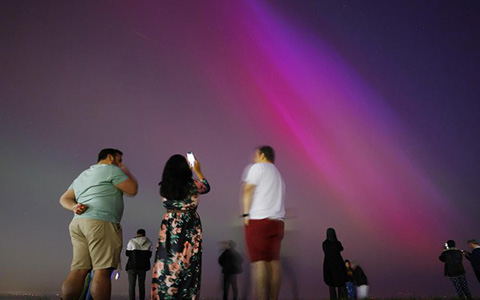Earth welcomed the strongest geomagnetic storm (also known as solar storm) in 20 years on the morning of May 11.
The strongest solar storm in 20 years caused a spectacular aurora. Photo: EPA
On the night of May 10 and early morning of May 11, the Earth welcomed the strongest magnetic storm (geomagnetic storm) in the past 20 years.
According to the Russian Academy of Sciences , the geomagnetic storm reached a level above G4 on the five-level scale set by the US National Oceanic and Atmospheric Administration to assess the severity of space weather events.
According to the scale, at G5, geomagnetic storms can cause large-scale power grid failures, seriously affecting satellites and radio communication systems.
Strong geomagnetic storms can cause headaches, fatigue, rapid heartbeat, high blood pressure, mood swings and insomnia.
The most powerful solar storm in more than two decades has hit Earth, causing spectacular auroras in many parts of the world . The aurora, with its glowing blue and green ribbons - seen from the UK to Tasmania - is expected to continue for the next few days. Many people in several European countries have been quick to post pictures of the magical aurora on social media.
Scientists say the best views of the aurora can be captured from mobile phone cameras, which can capture light better than the naked eye.
Curtains of green, pink and purple light, known as auroras, caused by geomagnetic storms can be seen in many areas of the world from Russia to the United States, as well as in parts of Latin America, including a rare appearance in Mexico.
The US National Oceanic and Atmospheric Administration described the event as “extreme” and warned the solar storm could pose a risk to radio communications, GPS and satellites.
However, Volker Bothmer, a leading astrophysicist at the University of Göttingen in Germany, said that although the solar storm was strong, it was not enough to cause significant disruption: “In the aftermath of an extreme storm, you can have a lot of problems with technology, infrastructure, communications, navigation systems, etc. But this storm is not so severe that we really have to worry about any serious damage.”
The last time a solar storm was detected that produced the most powerful pumpkin-colored aurora in modern history was on Halloween in October 2003. The spectacular event saw orange lights across North America and northern Europe. That year, the solar storm was so powerful that it caused blackouts in Sweden and damaged electrical infrastructure in South Africa.
Compiled by NGUYEN TAN
Source

























![[Maritime News] Wan Hai Lines invests $150 million to buy 48,000 containers](https://vphoto.vietnam.vn/thumb/402x226/vietnam/resource/IMAGE/2025/6/20/c945a62aff624b4bb5c25e67e9bcc1cb)
![[Photo] The 9th Congress of the Party Committee of the Office of the President, term 2025-2030](https://vphoto.vietnam.vn/thumb/1200x675/vietnam/resource/IMAGE/2025/6/20/78e7f27e8c4b4edc8859f09572409ad3)






































































Comment (0)